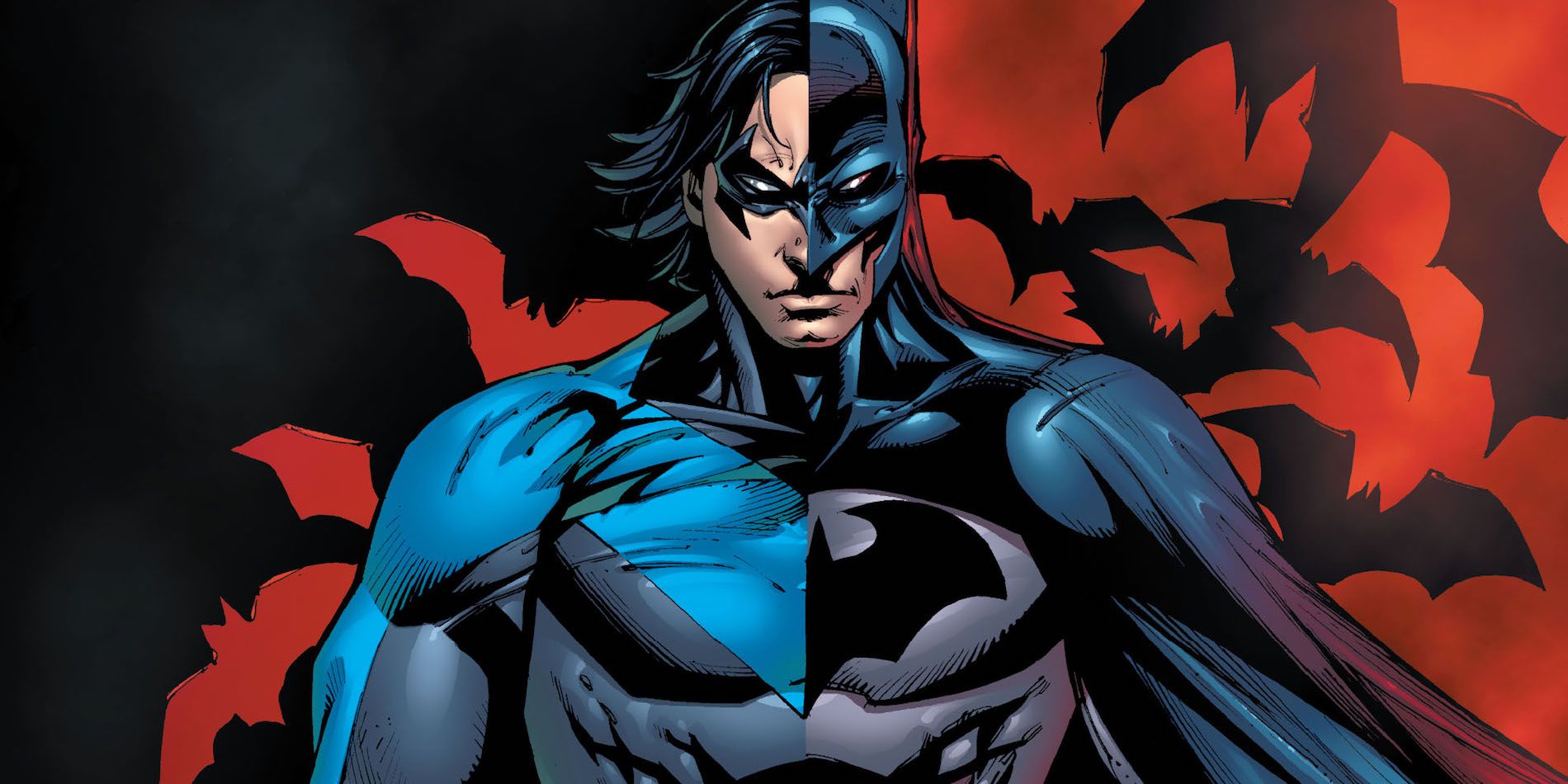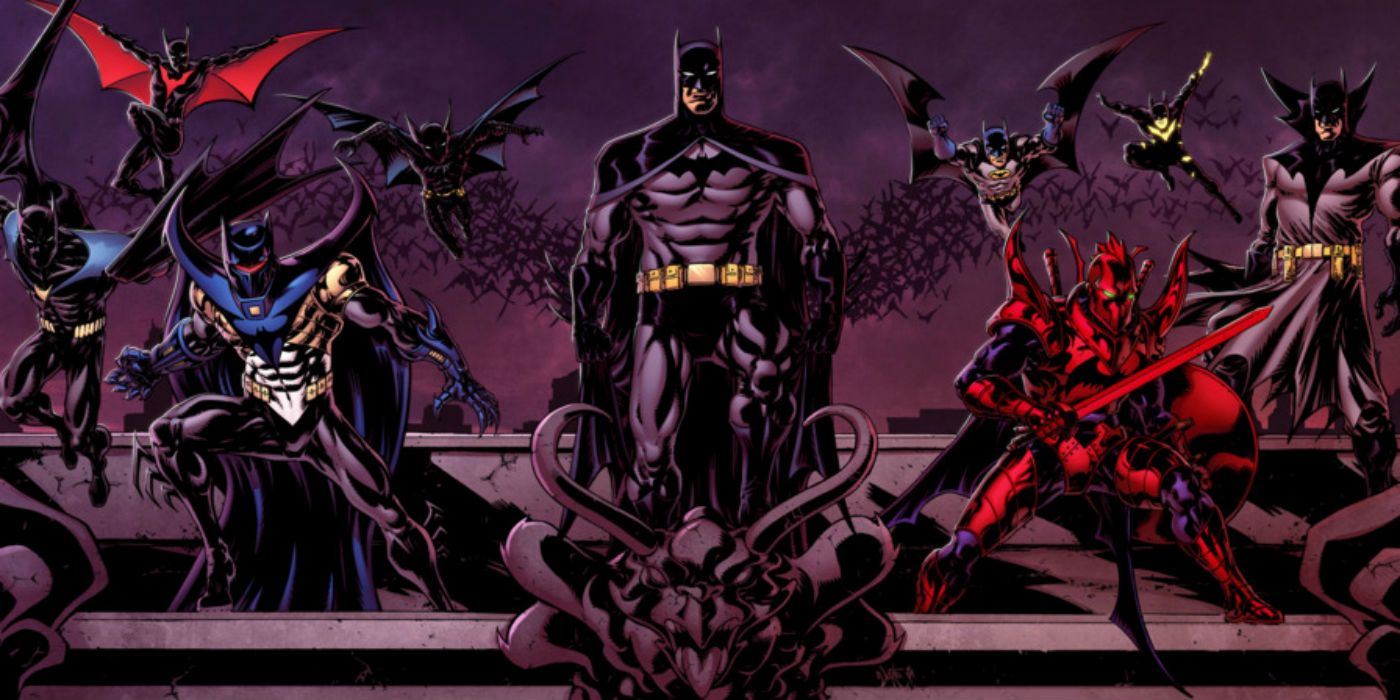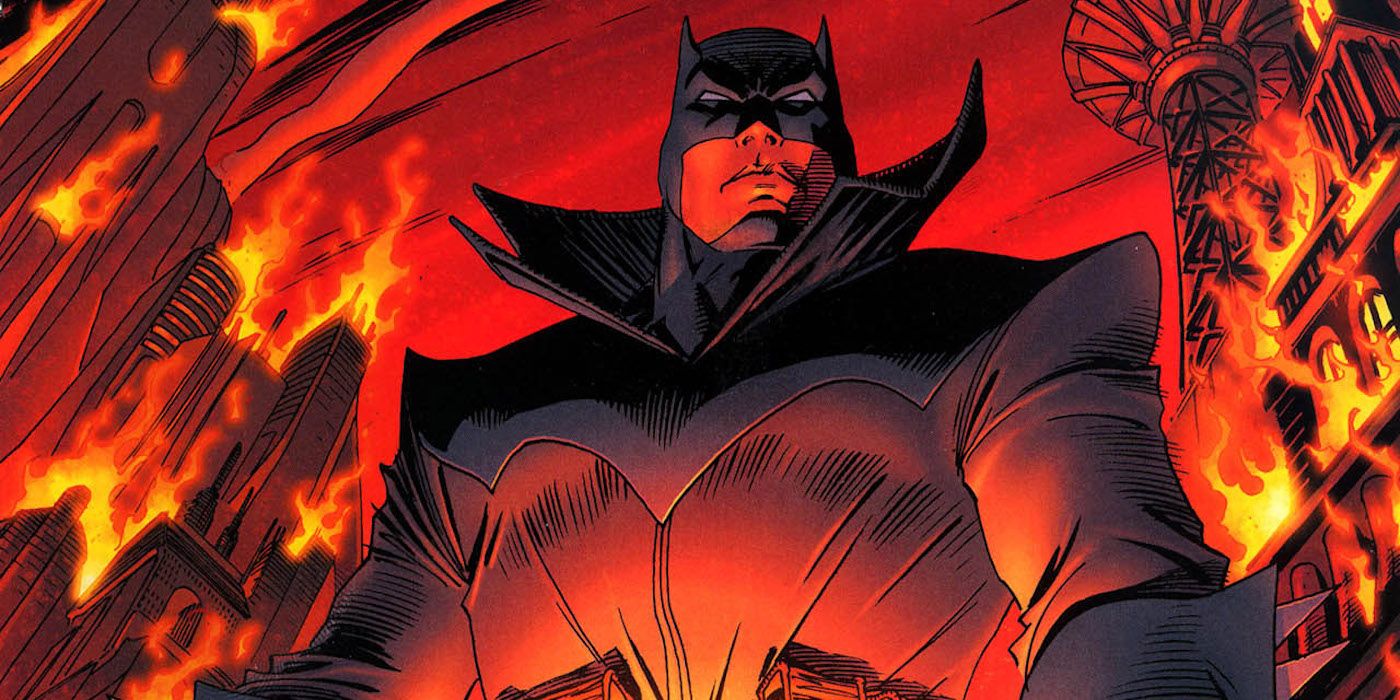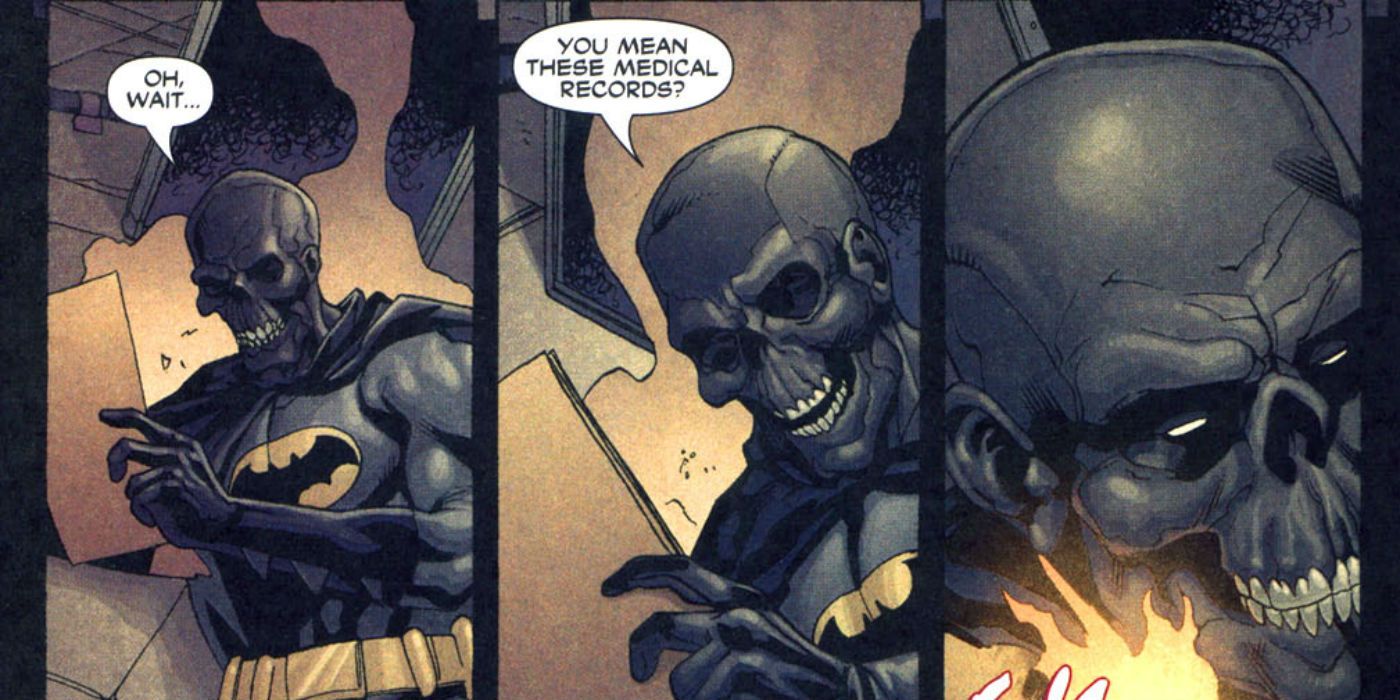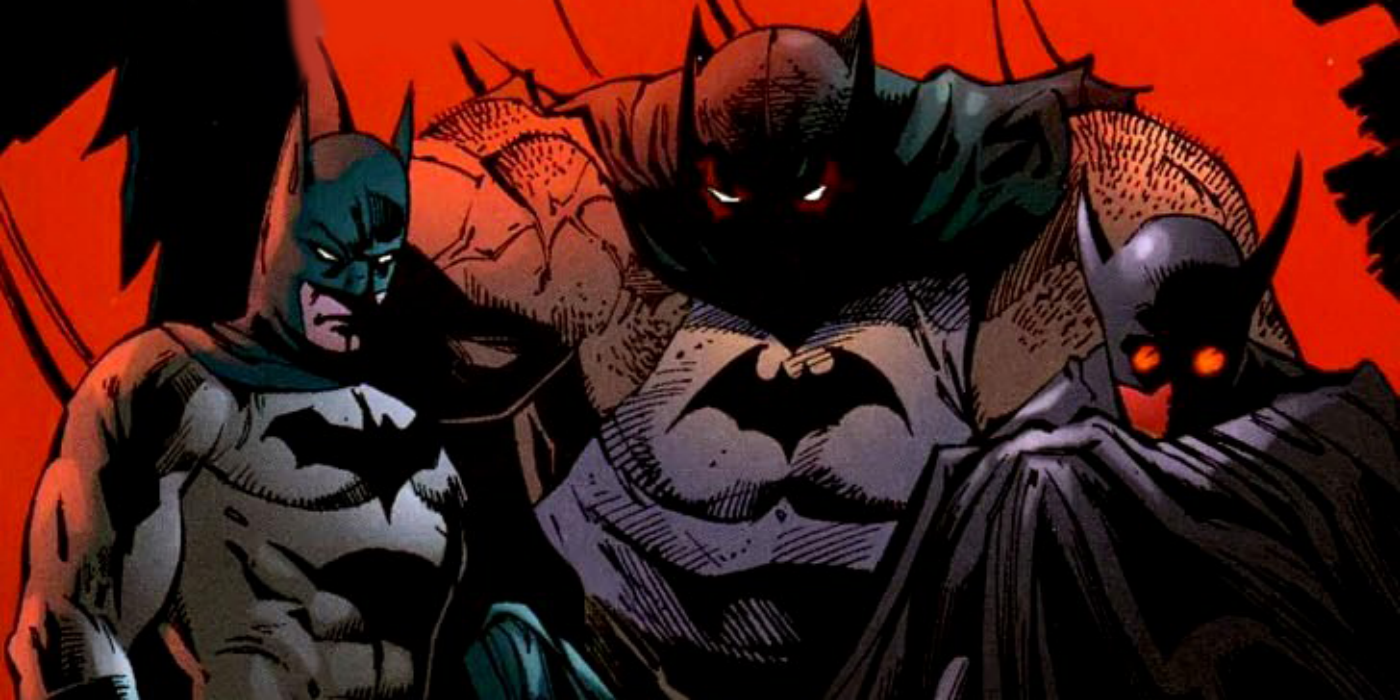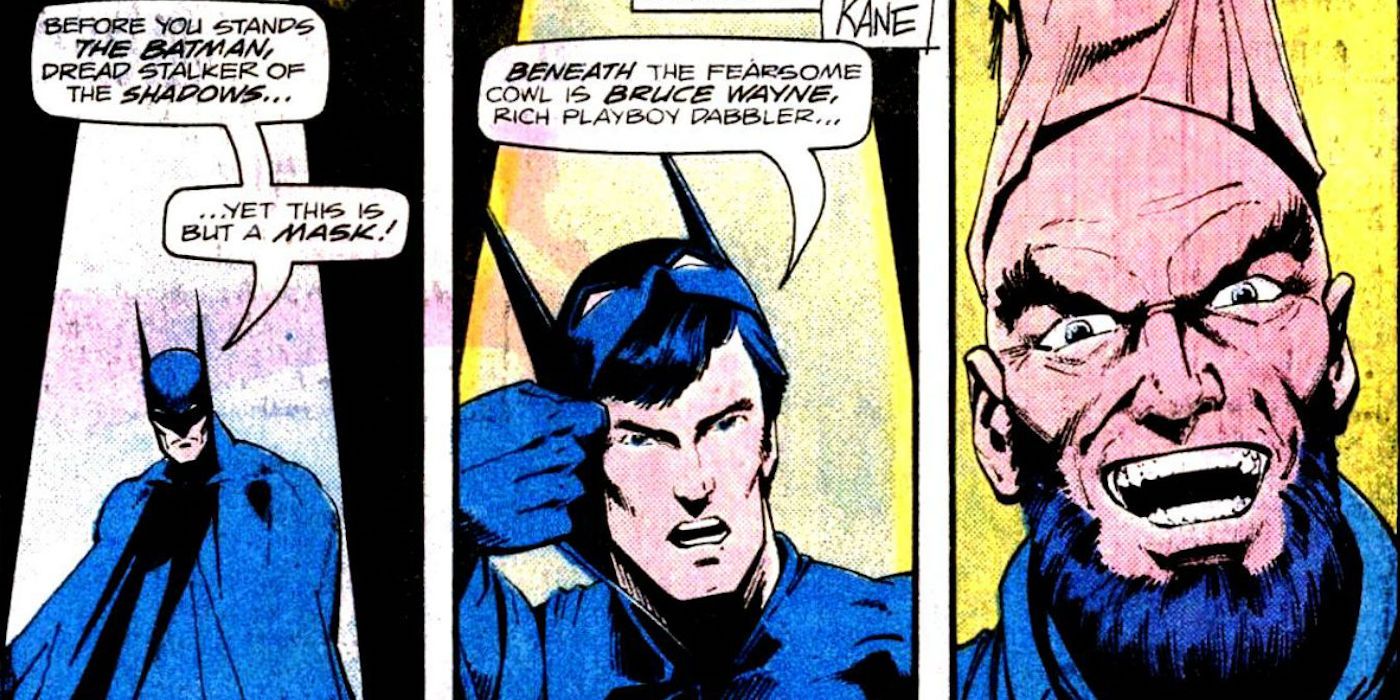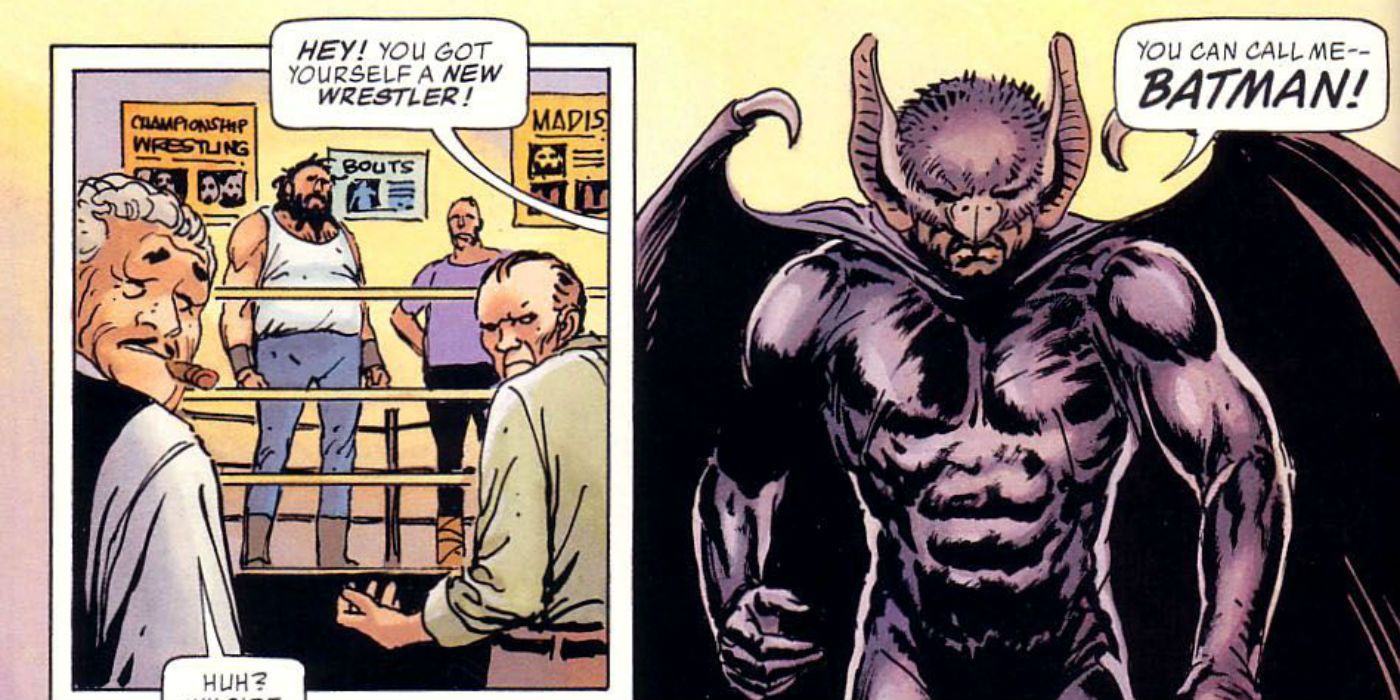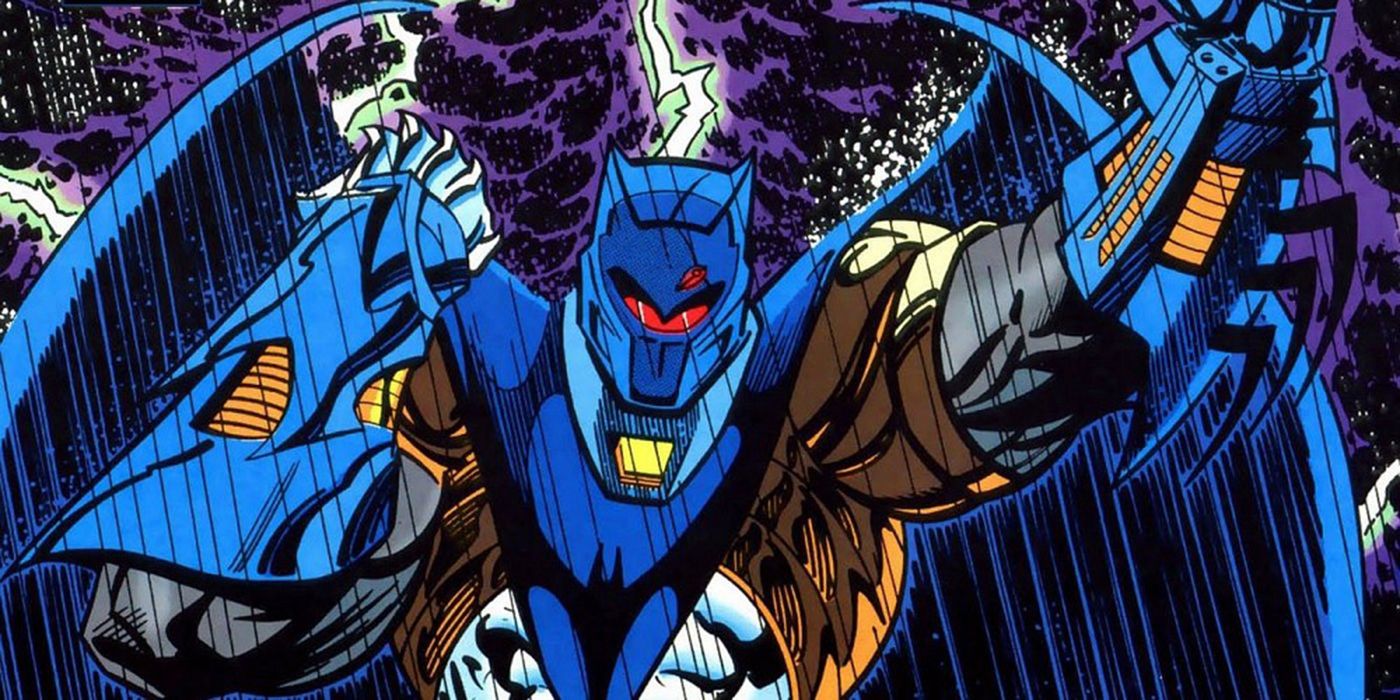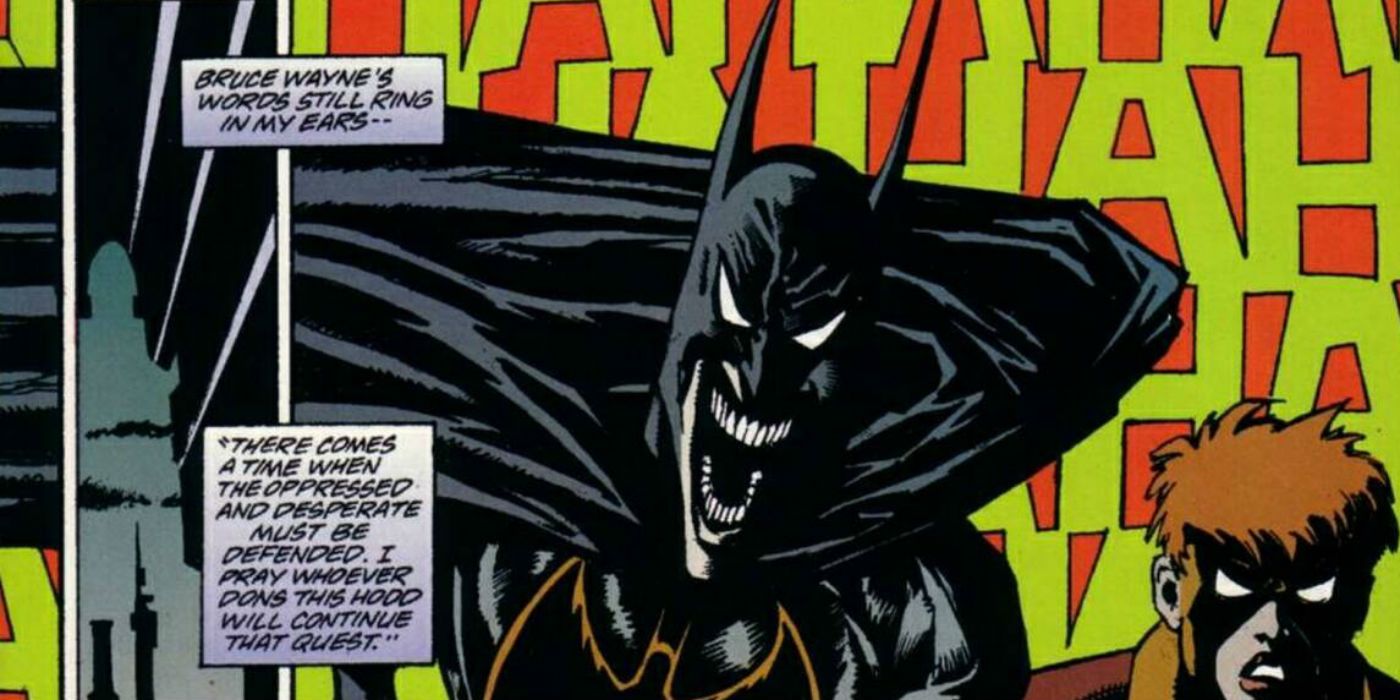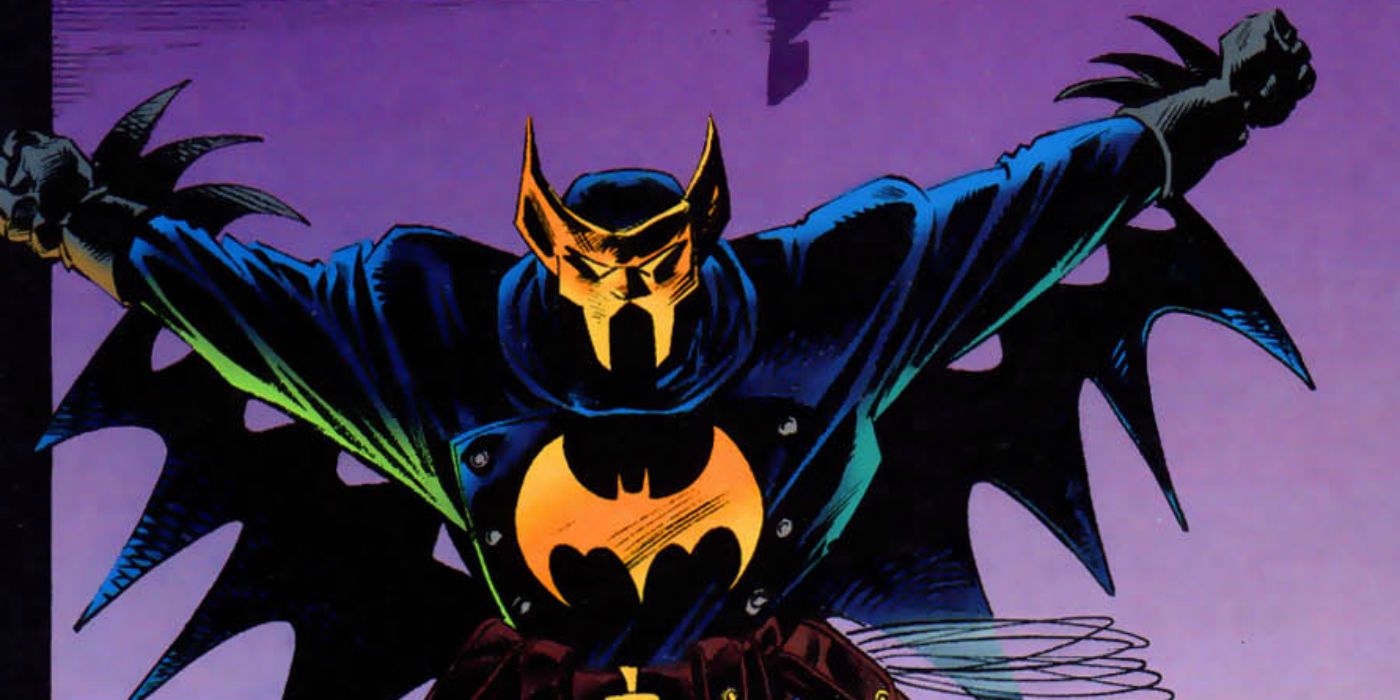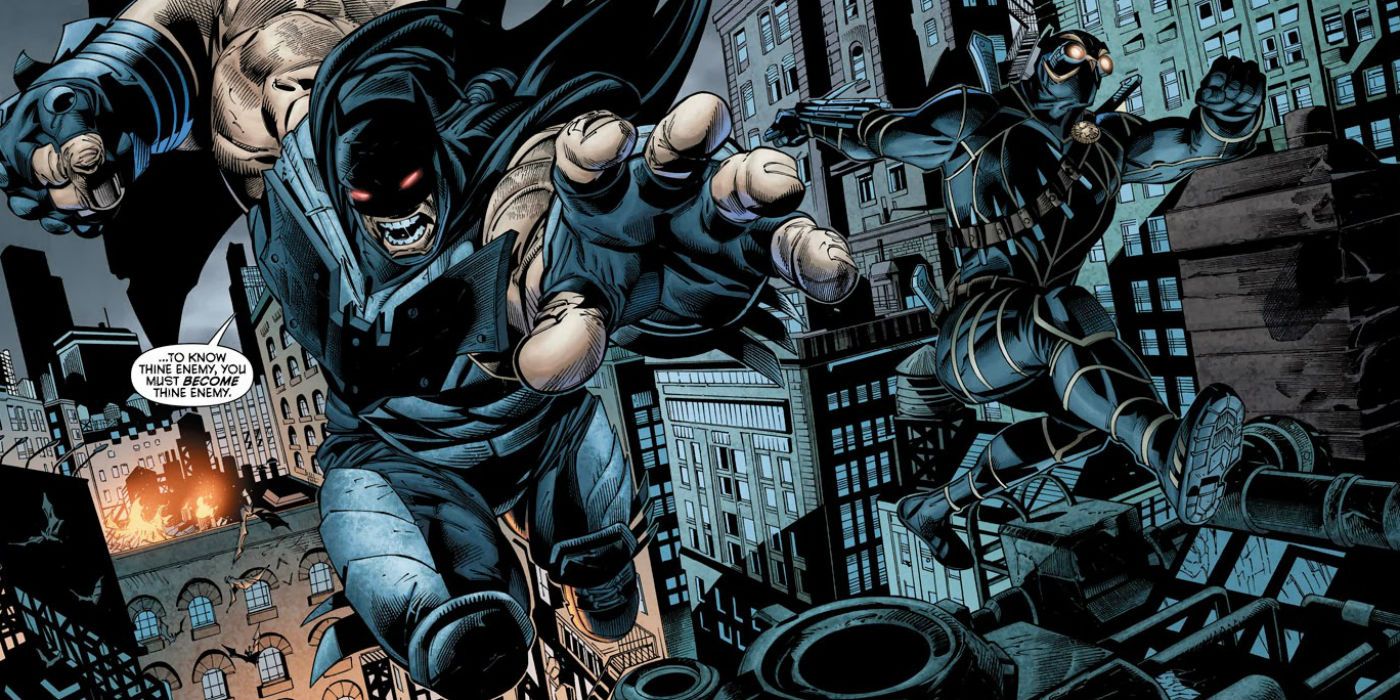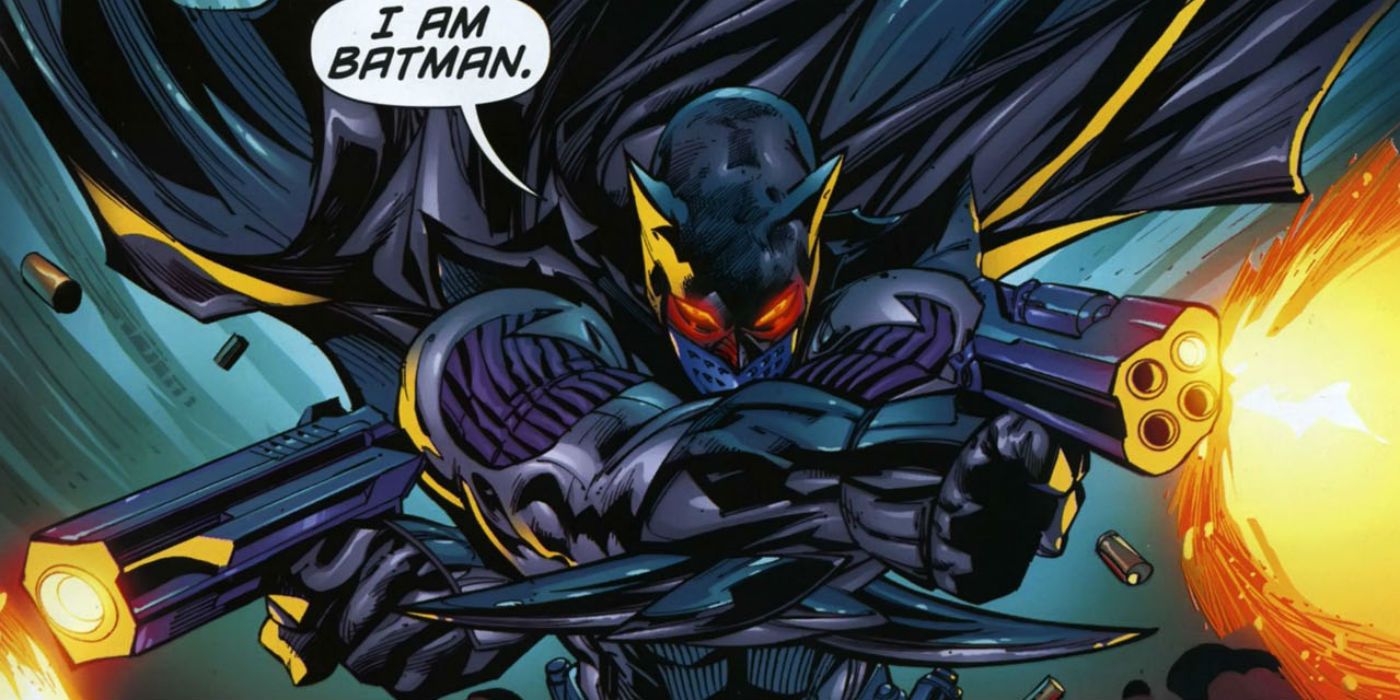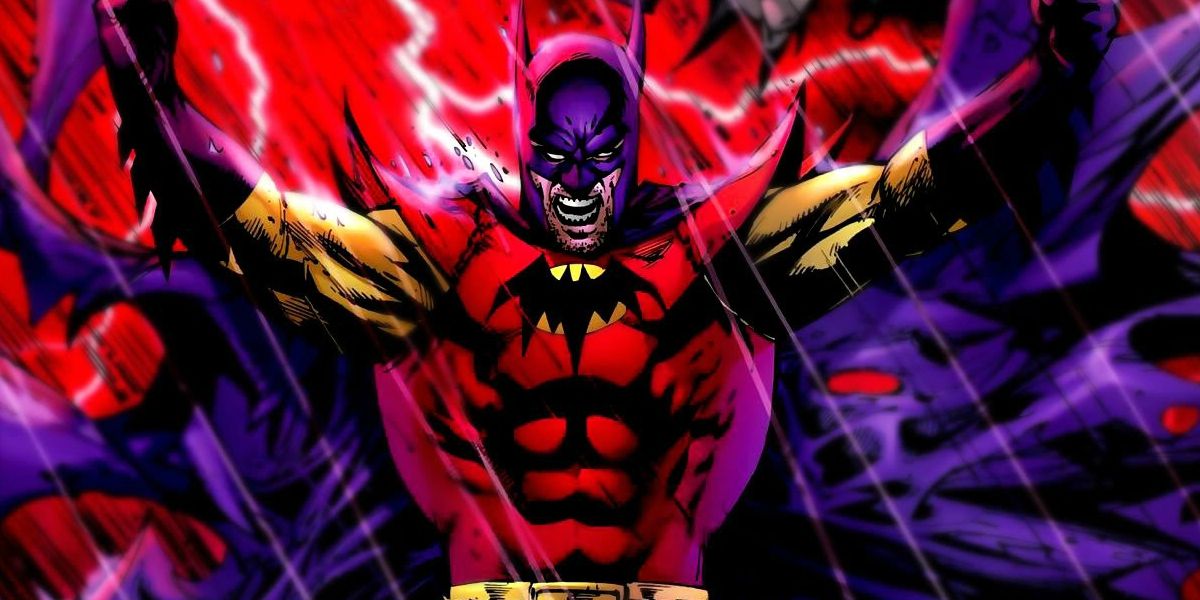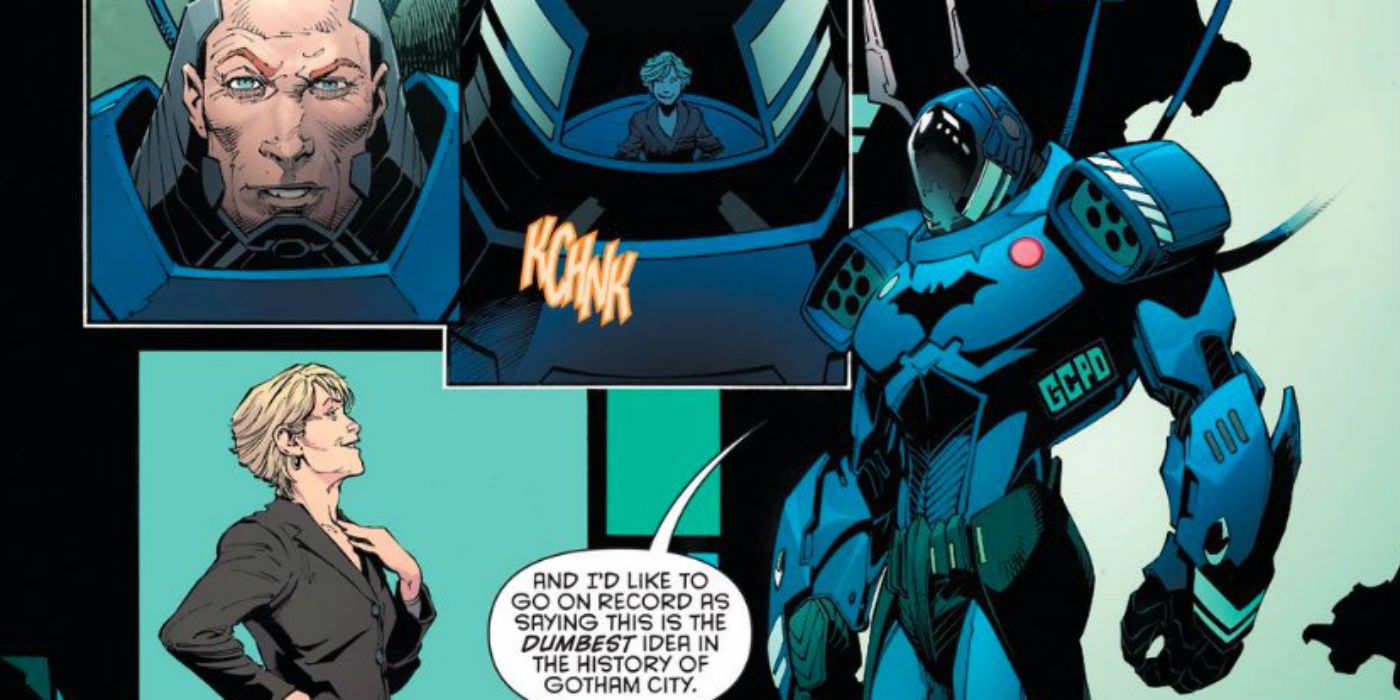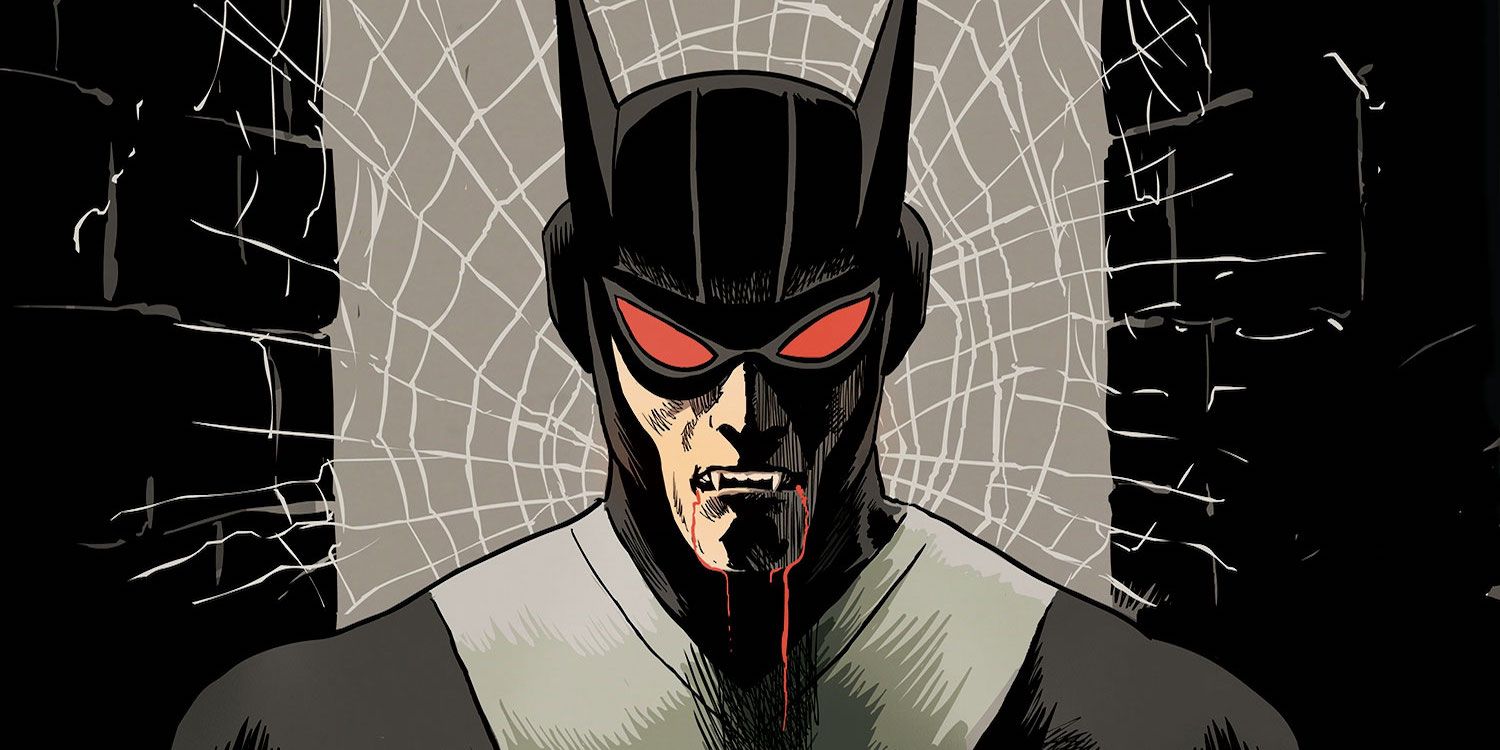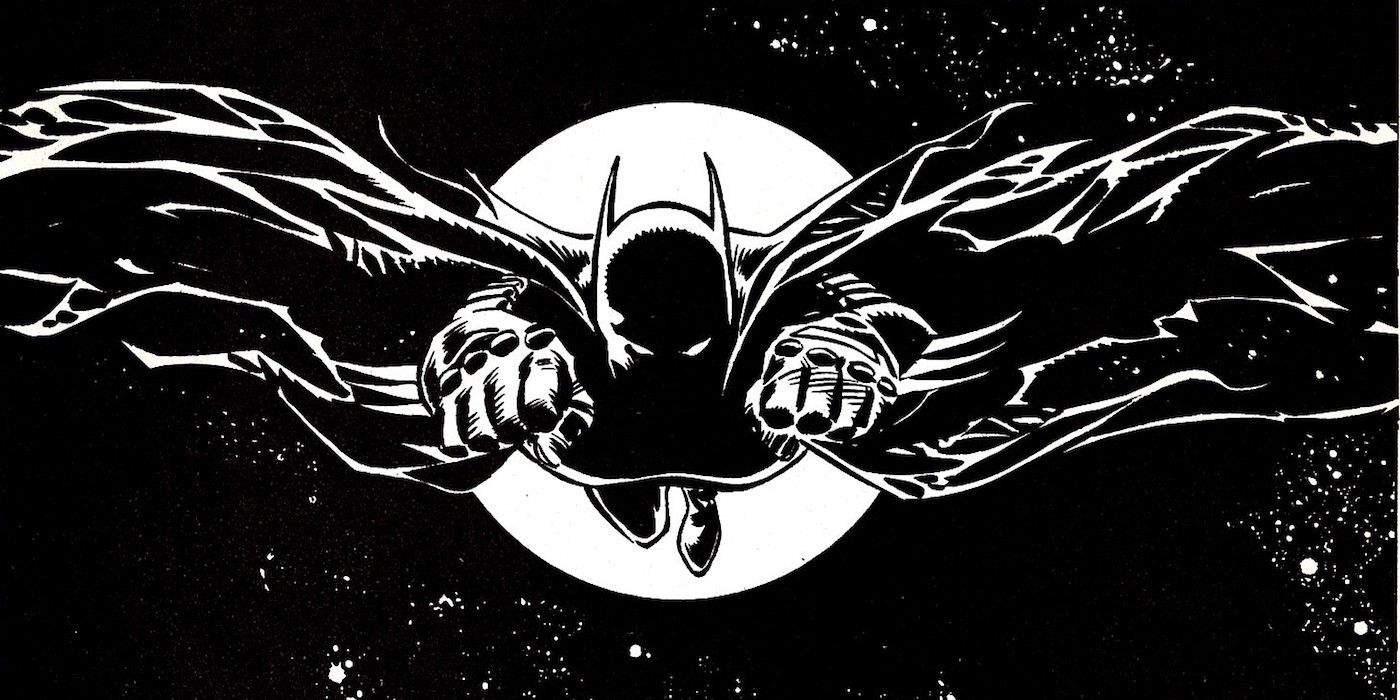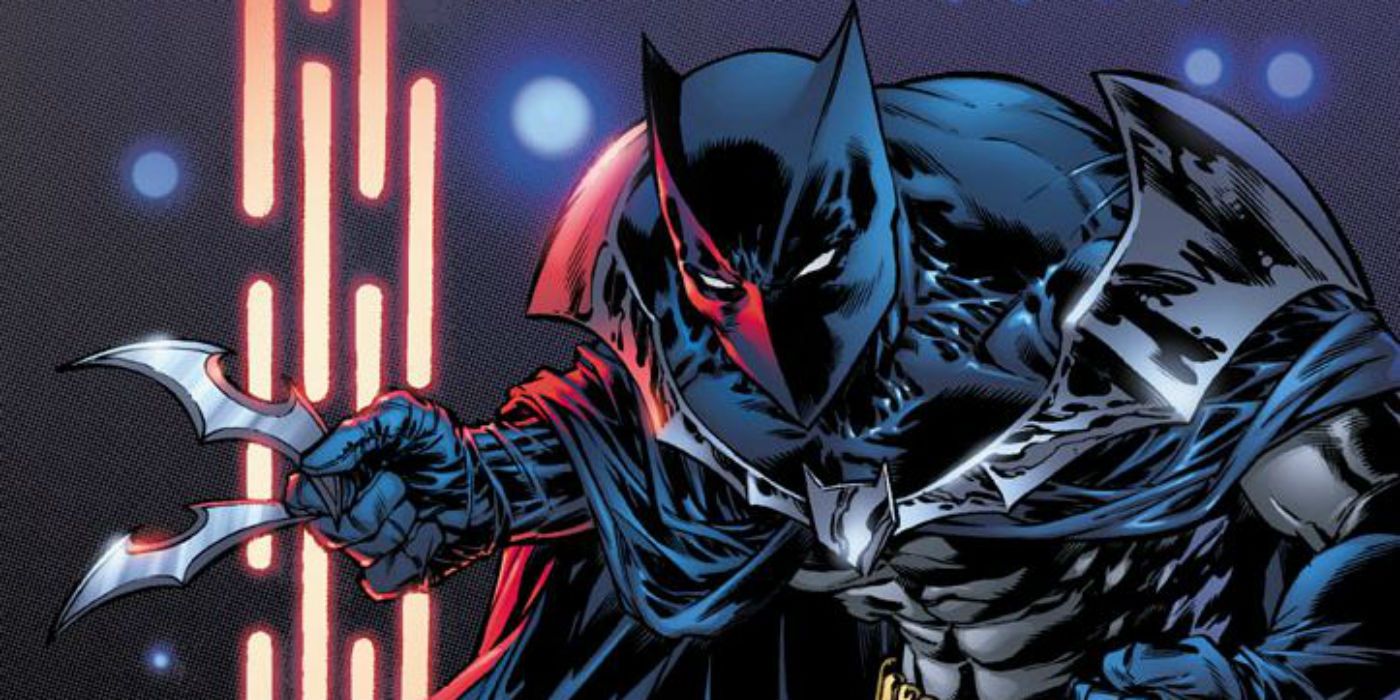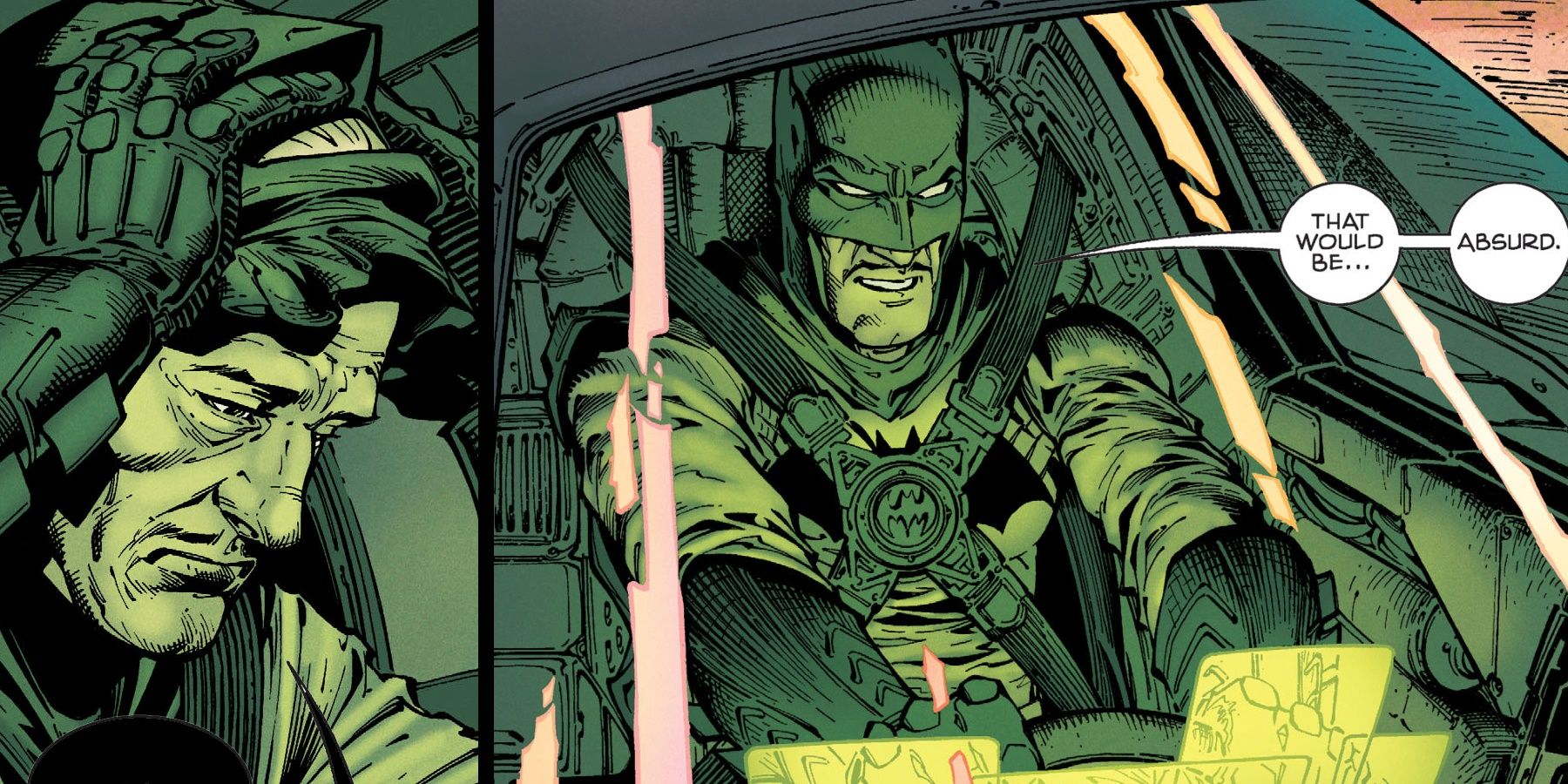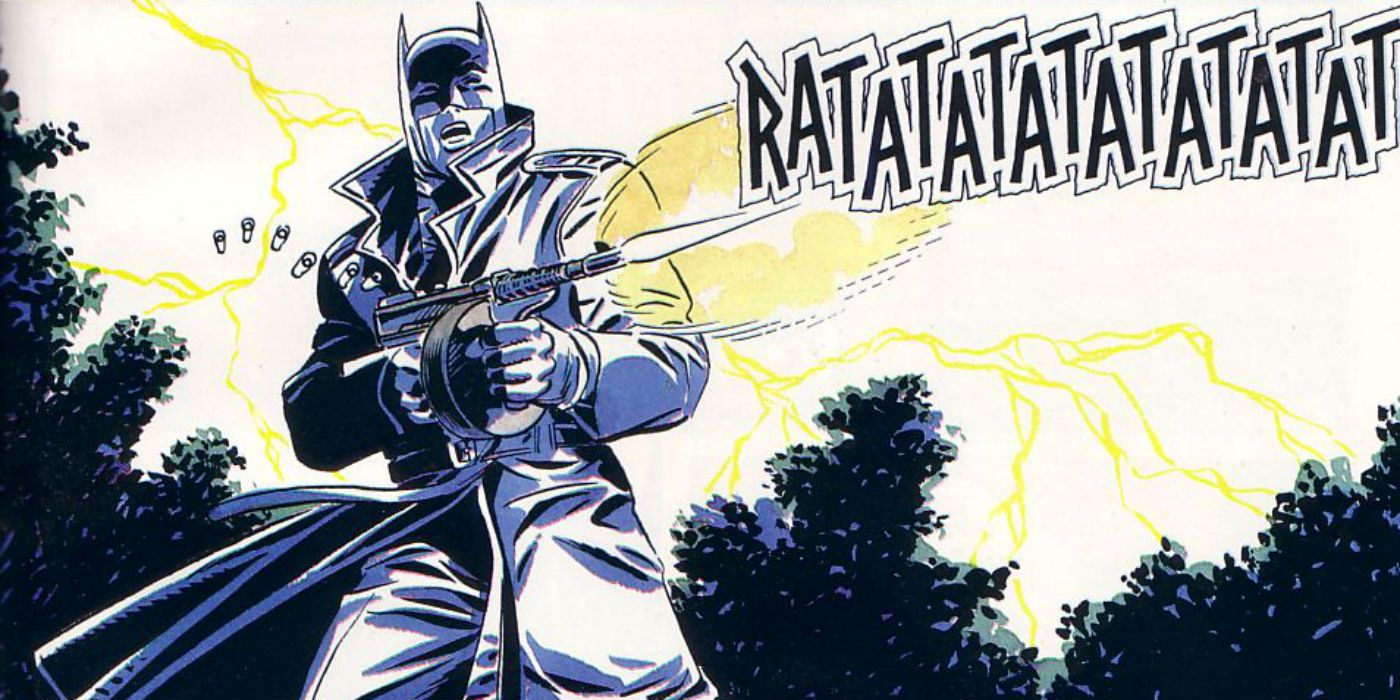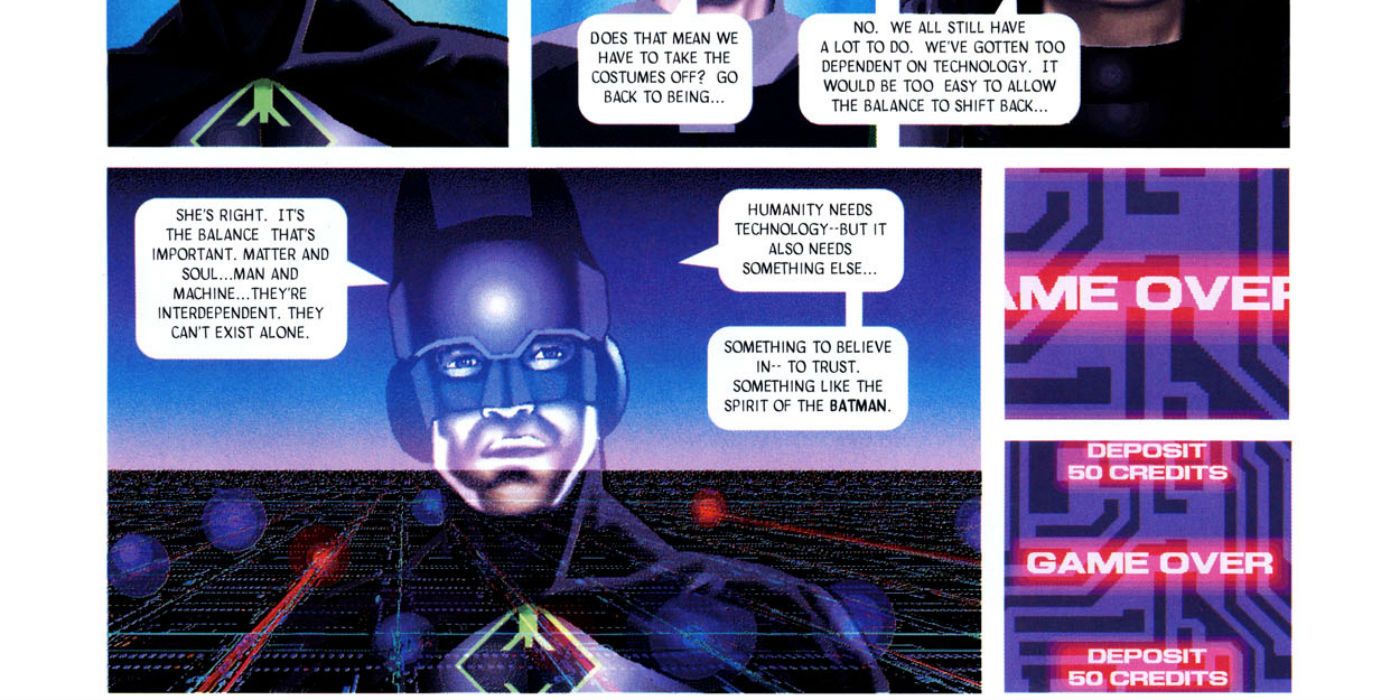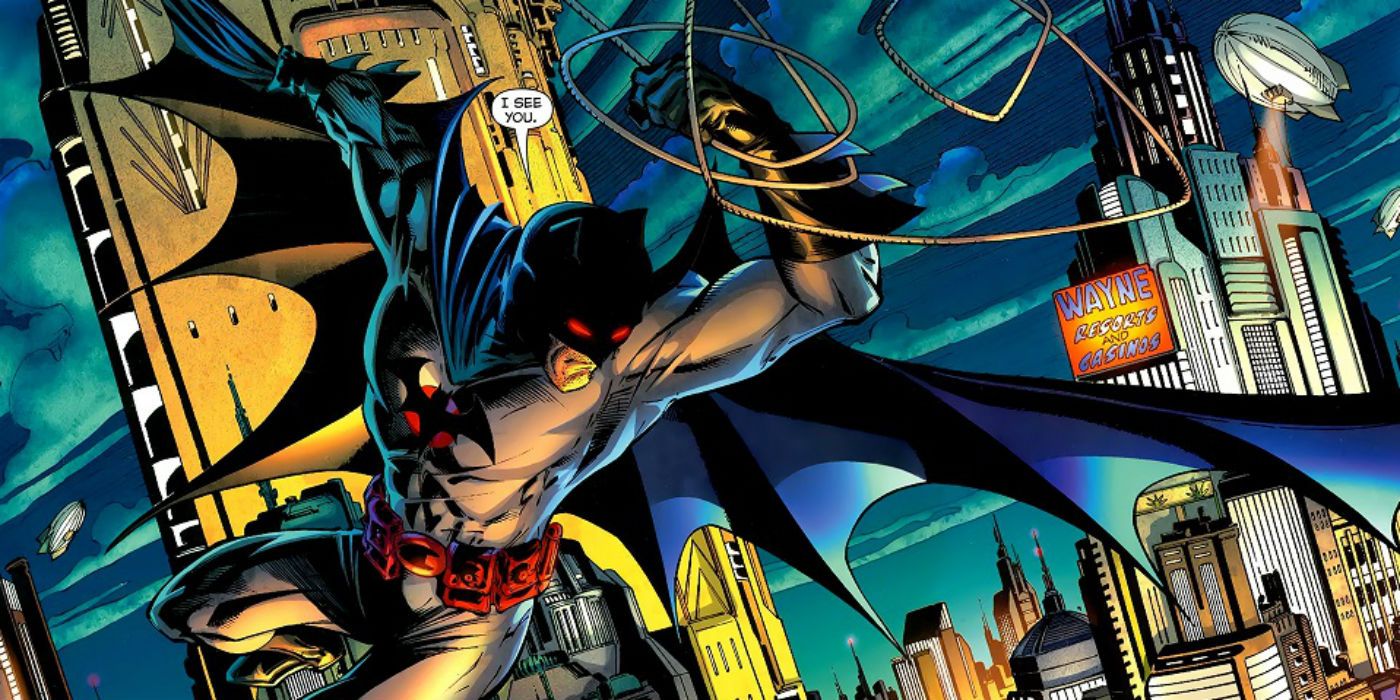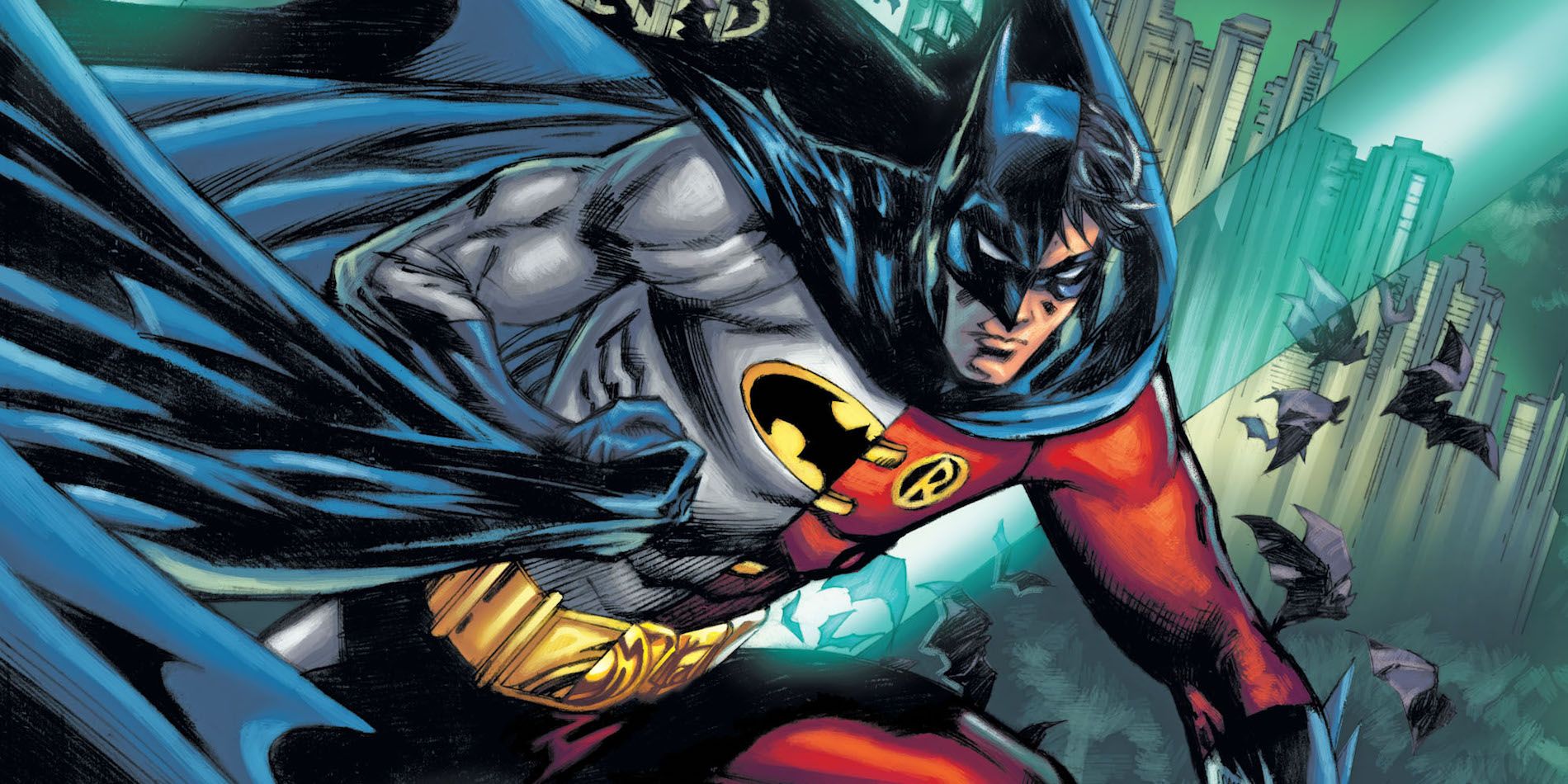Over the last 77 years, Batman has been adapted into every medium imaginable. Dozens of actors have portrayed him, and thousands of writers and artists have overseen him. When a character has been around as long as he has, there's no definitive or true version, nor is there even just one person that's ever been called Batman. Many men have taken up the mantle for a variety of reasons in a variety of stories. To rank them all would take some streamlining.
That said, there is only one Bruce Wayne. Even in Elseworlds stories that imagine the savior of Gotham as an elderly man, a vampire, a World War II veteran, or a steampunk hero chasing Jack the Ripper, they're the same man, just in different circumstances. The same goes for clones, replicants, and the like.
In stories like Batman: Year 100 or Superman: Red Son, it's unknown if these incarnations are Bruce Wayne (though the former is given his backstory, and the latter provides some insinuations). Others, like Midnighter, Owlman, Fatman, the Sons of Batman, and the Club of Heroes -- while clearly influenced by the original Dark Knight, either in-universe or by design -- are analogues who were either never officially Batman or are mere echoes of the Caped Crusader.
For this list, both the Bat and the man behind it have been considered. This is Every Character That's Ever Been Batman, Ranked.
24. Damian Wayne
Damian Wayne is a great character, one that's displayed clear character growth over the short time he's existed. From birth, Damian was trained to be his father's replacement., and although he eventually does fulfill his birthright, he ranks lowest on this list for one important reason.
Over several flash-forward stories during Grant Morrison's years-long Batman run, we saw an adult Damian strike out as a nigh-invincible murderous wrecking ball (having sold his soul to the Devil off-panel) attempting to avert the apocalypse in an increasingly hopeless Gotham City. With no allies and a GCPD that wants him dead, Damian's Batman is as much the villain of these stories as its hero. By the time the final story comes about, the only safe refuge from a Jokerized city is in Arkham Asylum. It's revealed that Doctor Hurt was somehow alive and working for the president, and it's intimated that he was behind Gotham's fall. He then talks the president into dropping a nuke on Gotham to save the rest of the country.
Of all the Batmen on this list -- some of whom are villains, mind you -- Damian still ranks below them all. Because for all the damage they did under the cowl, they never wiped Gotham City off the map. Many consider the Dark Knight to be a loner, though he was rarely ever truly alone; he always had allies or members of the Bat-Family to rely on. Damian was the Batman who never had anyone to pull him away from the darkness, and Gotham was nuked to smithereens as a result.
23. Black Mask
The War Games storyline saw several questionable creative decisions, chief among them being the treatment of Stephanie Brown. The first canonical female Robin, Stephanie was quickly fired by Batman and subsequently beaten to death by Black Mask. With the Caped Crusader distracted by grief and his growing unpopularity in Gotham City (his utilization of child soldiers being the primary factor), Mask decides to don the cape and cowl himself and escalate tensions, with the hope that this will lead Batman and the cops to fight each other and not him.
Crystal Brown, Steph's mother, goes on national television to discuss the death of her daughter. Black Mask, dressed in the Dark Knight's signature duds, swoops down and attacks. He starts beating and taunting the poor woman, shouting, "Your daughter was pathetic. A worthless good-for-nothing. You stupid, deluded, white trash piece of--" before Gotham's true hero comes in to save the day. Only by then it's too late, as the cameras had been turned off. The world had only seen Black Mask-as-Batman attack a poor woman who'd just lost her daughter on TV, not the real Batman making the save.
It wasn't until the Joker, furious that someone else had killed a Robin -- "That's my job!" -- that Black Mask's chaotic time under the cowl was finally brought to an end.
22. The Three Ghosts of Batman
Also known as The Replacement Batmen, these baddies were part of Doctor Hurt's attempts at creating his own army of depraved, amoral Batman soldiers. Each one represented an aspect of the Dark Knight's character, but since no one can be distilled down to a single trait -- especially the Batman -- each replacement was a failure. They simply didn't have the balance or fortitude the real Caped Crusader possesses in spades.
Josef Muller (on the far left in the photo above) represented Batman's pathology and obsession. A firearms expert, his refusal to allow the experiment to be over and his overbearing sense of responsibility forced him to appear as Batman, beat Joker half to death, and shoot him in the face. The second recruit was Branca (the big guy in the middle), and he was fed massive amounts of Hugo Strange's Monster serum and Bane's Venom. He is Batman's wrath -- his propensity toward violence. Reduced to nothing but an animal, Branca eventually started killing off the prostitutes and police officers who attempted to keep him calm. Michael Lane (far right) was Doctor Hurt's last shot. Realizing that a main ingredient to Batman's psychology is tragedy, Hurt had Lane's entire family murdered by Satanists (naturally). Unfortunately for the not-so-good-doctor, Lane couldn't come back from the trauma and was driven to insanity by his grief. This shouldn't have come as much of a shock for Hurt; not many people can shoulder the sort of trauma Bruce Wayne has endured in his lifetime.
This really shouldn't have come as much of a shock for Hurt; not many people can shoulder the sort of trauma Bruce Wayne has endured in his lifetime.
21. Hugo Strange
The villainous Dr. Hugo Strange was meant to be the Moriarty to Batman's Sherlock Holmes. Their "Reichenbach Falls" battle, along with the striking parallels between the two pairs of characters, have made that clear over the years. Strange developed a certain amount of respect for the Caped Crusader, but in helping Batman put a stop to crime lord Rupert Thorne and the Joker's laughing fish plot, he began to believe himself to be his superior as well. Having deduced his identity, Strange's obsession already had led to him posing as Bruce Wayne in the past, but he took it a step further this time around. He built replicas of the Batcave, Alfred Pennyworth, and even young Dick Grayson (which isn't super creepy at all, don't worry, Doc). Strange dressed himself up as Batman, challenged him to a brawl and fought a losing fight against the real deal. The villain then faked his death and disappeared.
Over time, Strange decided to play the slow game, taking measures to damage the stock of Wayne Enterprises, bankrupting his rival, and bringing Bruce's own house out from under him. Bruce was left a homeless pauper, and Child Protective Services took Jason (Todd, who had since become the new Boy Wonder) away. Strange then attacked Alfred and put him in a coma.
With Gotham all to himself now, Strange once again began dressing up like the Dark Knight, committing crimes and framing the real Batman for them. Strange's obsession with being Bruce Wayne/Batman only ended when he felt he'd truly won. For this villain, it was all about ego, and it wasn't enough that he knew the truth -- everyone else had to as well. He planned to reveal Bats' secret identity to the media, but Bruce managed to avert this, of course, thusly proving himself to be superior. Through the same mind games and manipulation Strange once employed, Batman left his nemesis questioning his own sanity.
20. Wayne Williams
DC Comics and Stan Lee teamed up to create Just Imagine, where Stan Lee would completely recreate the DCU in his own image. Unfortunately, without Jack Kirby around to share in the heavy lifting, this particular story comes across as bizarre and unfocused. Here, Batman is the code name of Wayne Williams, and he's based in Los Angeles rather than the fictional Gotham. He's sent to prison for a crime he didn't commit (naturally), but becomes friendly with Frederick Grant, a scientist who tutors him and teaches him how to sew (again, naturally). After saving the warden, Williams is granted a pardon and becomes a professional wrestler known as Batman. He keeps his mask on to remain mysterious, not wanting Handz -- the gangster who framed him and killed his father -- to know he was out of prison. With the money he earned from wrestling, Williams and Grant planned to take down Handz and the Church of Eternal Empowerment that funded him.
Batman and Handz have a final confrontation where the villain falls to his death. Along with Grant and Handz' former girlfriend Nita, they decide to fight for justice to "stop the other Handz of the world." It's...not the best.
19. Jean-Paul Valley
When the villainous Bane crippled Batman in the infamous Knightfall storyline, it was Jean-Paul Valley who took up the cape and cowl. Valley believed the Caped Crusader's crime-fighting methods were anachronistic, so he developed an advanced suit of armor and adopted a heavier ordnance package. Valley fought crime on crime's terms; he was brutally violent and merciless, and didn't care about collateral damage or saving people in the crossfire of his war. Whereas Bats fought crime with his mind and his body, Valley's mind was under strain from The System, a deep-seeded psychological conditioning from the Order of St. Dumas, the radical religious sect his family belonged to. Driven insane by the diametrically opposed philosophies of Batman and the Order, Valley's mind finally shattered.
JPV's run as Batman was viewed as a direct pushback by DC's editorial staff against fan criticism that the Caped Crusader's rules were outdated. At the time, (increasingly popular) characters like the Punisher and Cable were killing people left and right. To some, Batman's no-kill policy seemed like a half-measure by comparison; it had more to do with Batman's conscience than effectively eliminating crime. When Valley allowed a baddie named Abattoir to fall to his death -- an action which directly condemned an innocent kidnap victim to death -- while out on a mission with Robin, he became a target of both the Bat-Family and the GCPD. He was one of the more complex
He was one of the more complex Batmen, too be sure, but in the end, he'll forever be known as that crazy guy that Bruce Wayne had to beat the snot out of in order to become the Dark Knight again.
18. Joe Collins
I, Joker is a strange story, taking place in a world where a future evil Batman has set himself up as a god. He is worshipped and feared through displays of violence and recreations of mythic battles. Common people are forced into physical and psychological transformations to resemble Batman's greatest villains, and they're then given the task of trying to kill him to entertain the masses in exchange for their freedom. None succeed, and the analogue-villains are then executed to the glee of the people.
Joe Collins is chosen to be a Joker. Collins escapes by resisting the implantation of the Joker's memories and forcing his own personality to remain dominant. He links up with a small resistance network, where he learns that his Jokerized face can never be reversed. He and his comrades find the original Batcave and learn of the philosophies the true Batman lived by. We're never given any indication of how or why things changed so radically, or even if this is an isolated cult or something larger. Much of I, Joker is devoted to the strangeness of the world, but to the detriment of character and plot. Without any understanding of this reality, the story reads as more like a skeletal first draft that wants to be clever but isn't quite there yet.
Eventually, Collins manages to overthrow the evil Batman, after which he decides to take up the mantle himself in an effort to try to fix society's woes himself. While the image of a Jokerized man wearing a Batman mask is striking, everything surrounding it is pretty nonsensical.
17. Harvey Dent
Legends of the Dark Knight Annual #4, "Citizen Wayne" is a rendition of Citizen Kane -- with a whole lot more Batman. Bruce Wayne is an anti-Batman newspaper magnate found murdered alongside Harvey Dent. He and Dent grew up together, though their friendship had greatly soured in the weeks leading up to the murder. The crux of the narrative is the investigation, the suspects, and the characters that are still alive. In a defiance of expectation, it's revealed that Harvey is the Batman that's been on the loose, attacking mobsters and fighting a vigilante war. Prior to his murder, Sal Maroni had scalded him with acid, but both sides of his face were disfigured.
In standard continuity, when one side of his face was scarred, Dent's difficulties with duality created Two-Face, a decent man at war with his darker urges. The entirely scarred version in this particular iteration saw things with a pristine clarity, but with just as much conviction: justice is more important than law.
Dent didn't wear a mask because of any duality problems -- his reasons for choosing to model his alter-ego after a bat are never satisfactorily answered -- but because he wanted to protect his friends and family from any kind of reciprocity.
Bruce and Dent went to war with each other, resulting in Bruce trying to save Dent, but both ended up falling to their deaths. Throughout the one-shot, heroism is defined and redefined, and the remixes of relationships and situations make for an excellent, if brief, Elseworlds story.
16. Bane
There's a thin line between control and fascism. Batman often tiptoes that line (hell, he plays jump rope with it), and so does Bane. Their similarities make their interactions highly involving; they're really not all that different. During the Forever Evil event, Batman was missing and the Crime Syndicate had taken control over the planet. In the tie-in storyline Arkham War, Gotham is in chaos, with a multitude of factions divvying up the place. In response, Bane takes up the mantle of Batman.
The symbolism is important: Bane knows that there is something primal and mythic in the Batman mantle, something that means more in Gotham than anywhere else. The Dark Knight is a salve, a symbol, a deterrent, a levee; a man who's as respected as he is feared. Bane comes to Gotham with an army and forms tenuous bonds with Gordon and the GCPD. He enforces his rules and bargains with lesser criminals for the sake of order and attempts to draft others to join his side.
Overlooking the city, Bane reacts, "There is no power left...but me. There is no authority left...but me. There is no hope left...but me. There is no Batman. There is no Justice League. There is only Bane." When you think about it, his point of view is not so different than the Caped Crusader's own philosophy. Much of Bane's dialogue and actions in the miniseries echo a lot of Batman's own ideas and strategies, but are decidedly more deadly. They were never so similar as when they both had Gotham in common.
15. Jason Todd
Battle for the Cowl's Gotham is in a similar state as in our previous entry. Bruce Wayne/Batman was thought to be dead, and the city finds itself in the middle of a turf war. The only thing that could bring order was the rise of a new Batman, and the recently resurrected second Robin, Jason Todd, was the first to attempt it. At the time, DC editorial had him shifting back and forth between hero, villain, and antihero. Combined with the short space writer Tony Daniel had to weave the story, and Jason's arc within the story was relatively thin. The former Boy Wonder merged his murder-friendly policies with the meaningful symbolism of the bat, which appeared to be both a loving tribute to and a final insult against Bruce.
However, the narrative is too brief to be much of a character study on anybody, let alone Jason Todd, who appears as its main villain. His dialogue is pretty heavy on the psychotic rambling, which is unfortunate, because his feelings toward both Gotham and Batman are complicated. If done correctly, he might have come off as a balanced, understandable villain, rather than the cartoonish reverse-psychology game he was playing with Grayson. Still, the art is awesome, Daniels does respectable work, and we get three of Gotham's greatest characters (Todd, Dick Grayson, and Tim Drake) vying for the cowl in blockbuster fashion.
14. The Batman of Zur-En-Arrh
Having viewed Batman's heroic exploits through a powerful telescope, peaceful scientist Tlano became the Dark Knight of his world, Planet X (also known as Zur-En-Arrh). He eventually called upon Bruce Wayne to help him when his planet was under attack by a mechanoid race, as Tlano had figured out that the atmosphere on Zur-En-Arrh would give Bruce Superman-like powers. Together, the two would fight back against the alien horde and save Tlano's planet.
Tlano's Batman was retconned back into continuity for 2008's Batman: RIP story, where, rather than an alien scientist, the Batman of Zur-En-Arrh was a backup personality Bruce Wayne could activate if he was ever under psychological attack. This story -- and particularly the unapologetically gaudy suit -- revived interest in the character (as if it had ever waned). The Batman of Zur-En-Arrh became a skin in Lego Batman and Rocksteady's Batman releases, and the original story of Tlano was adapted for a 2010 episode of Batman: The Brave and the Bold.
13. Jim Gordon
Filled with odd character and story choices, Superheavy sees Jim Gordon becoming Batman when the real one was thought to be dead (again). Shaving his mustache, sporting a mech suit, a Mohawk, and somehow de-aged, Gordon snarked through his run with meta jokes about how bad of an idea this whole thing was. The brevity of the story makes for unbalanced pacing, and given its timing, it felt like a hollow and abbreviated remix of stories like Batman RIP and Batman Reborn. The exploration of what a Jim Gordon Batman would be is undermined, because the point of the story is to further define who Batman is by diving into who he isn't -- and it all came at the detriment of Jim Gordon's character.
However, his adversary Mr. Bloom -- an earthen Slender Man -- is built up to be a unique and legitimate threat. This turns into the redeeming quality of Gordon's run., as neither he nor Bruce could beat Mr. Bloom on their own. This implication makes Gordon look better, even if his time as Batman was too brief to judge appropriately.
12. Kirk Langstrom
Justice League: Gods and Monsters sees Kirk Langstrom become Batman after a failed serum to cure his cancer gave him vampire-like abilities. While ostensibly a superhero, he and the Justice League are considered a violent threat; Batman himself uses criminals to feed on. The arc of the alternate Batman, Superman and Wonder Woman sees each of them brought low, only to seek redemption, and still coming up somewhat short. For Langstrom, he's in love with Tina, wife of his best friend Will Magnus. He never acts on the urge, desiring to keep the friendship intact, but when Magnus finds out about this, and that Tina was in love with Langstrom as well, he murders her in a fit of rage and frames Langstrom and the Justice League. (It's not the brightest move.)
In a final confrontation, Will Magnus regrets what he’s done and takes his own life. Langstrom mourns the loss of his best friend and the love of his life, but gains a closer relationship with Superman and Wonder Woman. Throughout the course of the story, each is confronted with their past and their brutality, and in their regrets, find comfort in each other.
Note: the animated movie of the same name is much better.
11. Kal-El
While Superman has spotted for Batman in the past -- either to help cover up Bruce Wayne's identity or to make criminals believe he's still in the city when he isn't -- there is one story where he actually is Batman. Written by comics legend J.M. DeMattais, Superman: Speeding Bullets sees baby Kal-El rescued from his spacecraft by a childless Thomas and Martha Wayne. Given the name Bruce, his formative years are happy ones. Martha coddles and loves him, as does Thomas, though the latter is also very interested in where his adoptive son came from. Then the usual happens (the whole mugger in the alleyway thing). Bruce uses heat vision to burn Joe Chill to death, but he isn't able to save his parents. Through his grief and anger, he becomes Batman, and easily the most dangerous one on the list to boot.
Speeding Bullets is a complete remix of both the Batman and Superman mythologies. Lex Luthor becomes the Joker, Batman must fight him, and along the way, the question of nature vs. nurture is asked. This Bruce is broken, but can still be somewhat mended. The resilient and optimistic Kal-El we know from the regular universe is still in there. While most Elseworlds stories use their out-of-continuity status to end on decisive and bleak notes, DeMattais follows through on the character work. Instead, Bruce begins to recover thanks to Alfred and Lois Lane, and in desiring a better future, decides to become a better hero. He becomes Superman.
10. Batman (DC One Million)
The Batman of the 853rd century is a human with a certain number of bio-tech upgrades. He has an IQ of 1045, and like most humans of the era, he has some level of psychic ability. Like all Batmen, however, tragedy must strike first. His parents were guards on the prison planet of Pluto, and during a massive uprising, the criminal Xauron rounded up 15,000 of the guards and their spouses into an arena. Their children were made to watch as he slaughtered them, and a traumatized boy vowes revenge.
Due to the extensive and long-running history of his legacy, Batman was a well-known figure in this alt-future, even though none were currently active at that point. He decided to become this era's Caped Crusader because "Batman is not a man. I'm an ideal. I am justice." For him, Batman's greatest trait was his ability to strike fear, an idea that became a heavy influence on the design of his sleek, black uniform and informed on his methodology in fighting crime. Eventually, he would become Pluto's warden, where his actions became too vicious. Realizing the legacy he had become a part of, Batman built himself a partner, Robin the Toy Wonder, to act as his conscience and as a reminder of the innocence he lost but is sworn to protect.
9. Alfred Pennyworth
Having only been published a few months ago, the most recent entry on our list sees Bruce Wayne's faithful butler and father figure donning an ill-fitting Batsuit and racing into the city in a Batmobile. A Superman-like hero-turned-villain called Gotham was wrecking havoc downtown, and Wayne was too far away to lend a hand. Alfred ran Gotham down in the Batmobile, but it was not enough, and unfortunately, being Batman meant Alfred couldn't carry his trusted double-barreled shotgun. Eventually, they came face to face, and Alfred -- doing his best Dark Knight impression -- allowed his cape to spiral over him and he hunched forward to be intimidating. Even Alfred's gruff "I'm Batman" didn't lend credence to his lie, nor did the pencil-thin mustache or the large Batsuit that made him look like a kid wearing his dad's clothes.
Alfred's run as Batman lasts only a few pages. While played for laughs, Alfred's moment was badass, and is outdone only by the time he broke Superman's nose.
8. Eliot Ness
Scar of the Bat is one of the stranger Elseworlds Batman stories you'll ever come across. Here, the fictional Gotham City and all its denizens do not exist. Presented as an adaptation of true events, Scar of the Bat stars Eliot Ness, the real-life Prohibition agent who helped take down Al Capone (made even more famous by the film The Untouchables). Frustrated with criminality both in his department and by the gangsters running roughshod in Chicago, our hero has had enough. Inspired by Zorro and the 1920 play
Inspired by Zorro and the 1920 play The Bat, Ness dons a stylized Batsuit (that would later influence Damian Wayne's costume) and fights crime with a baseball bat (which earned him his name) and a Tommy Gun. Admittedly, the plot gets somewhat predictable as it tries to stay somewhere within the lines of believable history. But the snappy dialogue, riddled with just the right amount of '30s and '40s slang, along with the shadowy noirish art and the obvious fun creators Max Allan Collins and Eduardo Barreto are having with the whole thing, make this svelte story more than worthy of a read.
7. James Gordon
In Batman: Digital Justice, the Gotham in the near-future is a cyber-punk dystopia. A malignant and possibly living computer virus calling itself The Joker suddenly infects banking and protection systems, eventually making the robot police force kill the human police officers while leaving actual criminals to go about their business. Jim Gordon's grandson, also named Jim, is a police officer looking to avenge his dead partner, who'd been killed because of the Joker virus. Learning about the history of the Joker through a computerized Alfred, James Gordon becomes a Batman for a digital age. As more of Gotham's history becomes known, others take on familiar roles: an updated Robin and Catwoman enter the plot, first as enemies and then later as allies.
While the digital art hasn't aged too well, the concept is a raw and inspired take on the Batman mythology. The future here is rendered uniquely and carefully, and while clearly influenced by William Gibson and Blade Runner, it never feels derivative. The techno-paranoia is a perfect fit for the Caped Crusader, and its delivered wonderfully in this frontier story.
6. Thomas Wayne
Thomas Wayne, Bruce's father, was Batman on two occasions. In a Silver Age story called "The First Batman," Thomas and Martha host a costume ball where Dr. Wayne is dressed as a bat. Local thug Lew Moxon's gang kidnap him from the party to remove a bullet from Moxon's shoulder, and while the good doctor does his job, he also manages to overpower Moxon and his thugs and contact the police. After a decade spent in jail, the villains is eventually released and in search of revenge -- but he needed an alibi to pull it all off. Moxon hires Joe Chill to kill Thomas and Martha, though he instructs the hired gun to leave young Bruce alive so that he can positively identify that the shooter wasn't Moxon (who would be the biggest suspect for obvious reasons.)
Wayne's second tenure as Batman was just as tragic. In the Flashpoint reality (a displaced timeline that was never meant to exist) Bruce was the one gunned down that night in Crime Alley, not Thomas and Martha. Under this Batman, Gotham was seedier but more structured, though the elder Wayne was deeply cynical to the point of nihilism. But when Thomas learned of the reality where Bruce had survived that fateful night, he finds new purpose. For him, knowing his son would live -- even if it's as Batman -- would be far better than death, and Thomas eventually sacrifices himself so that the original timeline could be restored.
5. Tim Drake
Bruce Wayne might be the World's Greatest Detective, but it was something he had to learn. Tim Drake, Bruce opines, is a natural in the art of detection. Tim figured out Batman and Nightwing's true identities as a young teen using only his wits and some newspapers. Over the years, he proved himself to be nearly as good of a detective as Bruce, and nearly matches the world-class computer skills of Barbara Gordon's Oracle. Tim Drake became Batman more than once. The first was during the Titans of Tomorrow, a dystopic possible future where the Teen Titans took up the mantle of their mentors, only for them to become murderous, corrupt, and amoral. When confronted with the man he will eventually become, Tim Drake put a gun to his head, ready to end his life to save the future from himself.
In Battle for the Cowl, he was only Batman briefly, largely to prove to Dick Grayson that Gotham needs a Batman, and that the eldest Boy Wonder was the most qualified candidate for the gig.
Most recently, Tim Drake took up the Batman Beyond mantle when Terry McGinnis was killed during the Convergence event. Seeing a dark future where Brother Eye has taken over the world, Drake manages to go back in time to hinder Brother Eye, but not stop him completely. He then returned to the future and finally defeated Brother Eye once and for all, a feat nobody -- not even Bruce Wayne himself -- ever managed to do.

